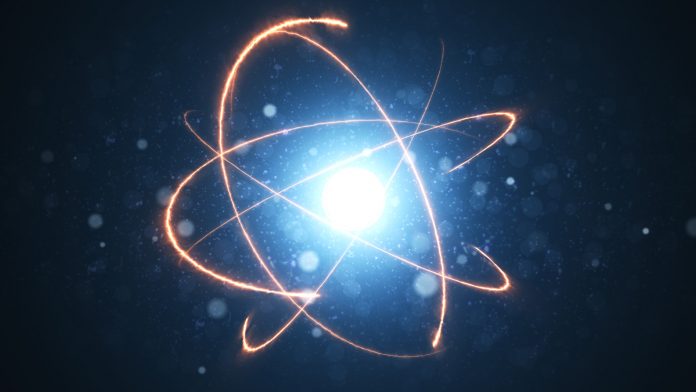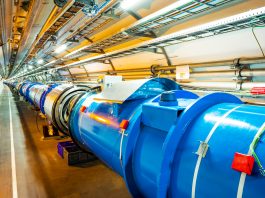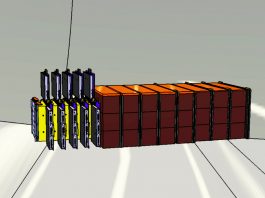Following the recommendations of the European Strategy for Particle Physics, CERN and its international partners are now studying the technical and financial feasibility of a 100km circular collider, the Future Circular Collider integrated project.
The Future Circular Collider (FCC) will host a Higgs and Electroweak Factory, followed by the highest energy frontier machine ever made, which will offer a rich physics programme until the end of the century.
The Higgs boson broke the news worldwide on 4 July 2012, when the ATLAS and CMS collaborations at CERN announced its discovery. This boson completed the Standard Model (SM) of elementary particles, which successfully describes all High Energy Physics (HEP) observations. With this discovery, the community of particle physicists also knew that an exciting era was opening. The Higgs boson is indeed unique among elementary particles, both by its nature (it is the only elementary particle to have no spin) and because of its novel interactions with elementary particles of matter. Shedding light on the Higgs’ properties will help us understand how it is related to other open questions in modern particle physics and its role in the evolution of the Universe. Indeed, there are well known ‘unknowns’ in our understanding of the Universe as shown by the few examples given below.
For instance, we know that dark matter and dark energy amount together to 95% of the energy density of the Universe, but their nature still needs to be understood. A dark matter elementary particle in the TeV1 mass range is a good candidate to be searched for at accelerators, as is being done at the CERN’s Large Hadron Collider (LHC) and its HL-LHC upgrade programme, which will extend until the late 2030s. But future, more precise or more sensitive investigations will be crucial to unravel its mysteries if it has been discovered, or simply to search for it if it was not in the sensitivity domain of the LHC or other presently running experiments.
The fact that we live in a Universe composed of matter, the antimatter having disappeared by matter-antimatter annihilation just after the Big Bang, contradicts the predictions of the Standard Model and requires additional sources of violation of the matter-antimatter symmetry as well as matter-antimatter transition; this might (or might not) be related to the unexplained origin and values of the masses of neutrinos, which differ strongly from their associated charged leptons. Finally, the origin of the existence of three similar families of particles, while only one is sufficient to compose our visible Universe, remains mysterious.
Many of these questions, and others, as further detailed in References one and three, may be solved by the existence of new particle physics phenomena – all of which require an extension of the SM, but within a very large range of energies and interaction strengths. Evidence for this new physics ‘beyond the SM’ can be obtained by high precision measurements of SM particles properties, searches for tiny violations of the SM conservation laws and for rare phenomena, or by searching for new particles at high energies. This variety of cases shows that the future of particle physics necessitates a multi-pronged approach and that the accelerator branch must rely on a versatile infrastructure/programme like that offered at CERN by the LEP/LHC complex, and the one foreseen with the FCC-int project (FCC-ee followed by FCC-hh), which will provide the highest precision, sensitivity and energy, to explore the known and unknown unknowns as thoroughly as possible.
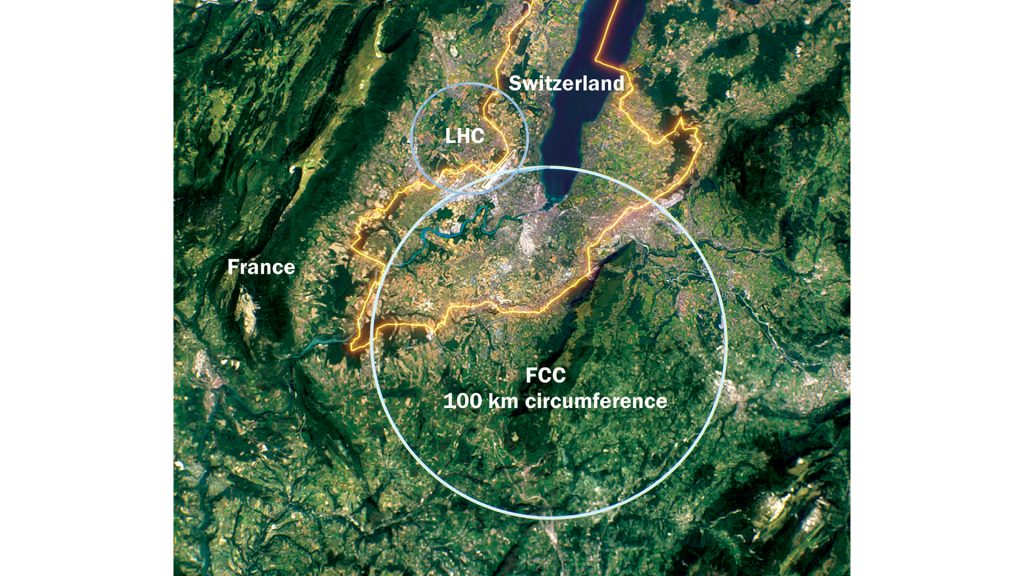
The Future Circular Collider and its competitors
Different machines have been proposed to study these fundamental topics and these studies have reached a good level of maturity as they have been taking place for a decade or more. Broadly speaking, there are two approaches, one with a circular machine, which reuses its bunches of particles over many turns making them collide again and again, thus offering very high collision rates in the interaction regions where are located the detectors (two or four for the FCC), and the other, with a linear machine in which the particle bunches coming from two linear branches collide head-on only once in a single interaction region but in an extremely focused mode to also increase the collision rate.
The CERN community and its international partners have proposed one machine of each type for an ambitious collider project after the LHC. The Future Circular Collider (FCC), which could run first as a Higgs and Electroweak factory in e+e– collisions (FCC-ee), may also ultimately reach a centre-of-mass energy of 100 TeV in proton-proton collisions (FCC-hh), and the Compact LInear Collider (CLIC) which could reach an energy in e+e– collisions of 3 TeV.
In Asia, for many years Japan has been a candidate to host the International Linear Collider (ILC), which has now a setup optimised for studying the Higgs boson, i.e. running at a lower centre-of-mass energy than initially foreseen (250 GeV in ee collisions, while 1,000 GeV could be reachable), since the Higgs mass is 125 GeV. Chinese physicists have more recently proposed to build the Circular electron-positron collider (CEPC) which is quite similar to FCC-ee, with also a possible hh extension, SppC.
Between 2018 and 2020, the European Strategy Group has coordinated the process of recommendations for the future of the worldwide particle-physics landscape. It concluded that an electron-positron Higgs factory is the highest-priority next collider and, for the longer term, that the European particle physics community must have the ambition to operate a proton-proton collider at the highest achievable energy. To reach such a goal, it says, ‘Europe, together with its international partners, should investigate the technical and financial feasibility of a future hadron collider at CERN with a centre-of-mass energy of at least 100 TeV and with an electron-positron Higgs and electroweak factory as a possible first stage. Such a feasibility study of the colliders and related infrastructure should be established as a global endeavour and be completed on the timescale of the next Strategy update.’
The FCC integrated programme (first ee at different energies, then in a second stage hh collisions at the highest energy) will provide the richest Higgs physics programme. It would also be the best electroweak factory by far, provide additionally Heavy flavour and Quantum Chromodynamics (QCD) physics programmes, and allow for extensive searches beyond the SM (BSM) both for high masses and small couplings.
The CLIC approach is not optimal for the observed Higgs mass. It should thus rather be continued as an R&D programme and be revisited later in case the FCC could not be done. The ILC would be another option for a Higgs factory, in particular since it may be ready slightly earlier if its funding materialises rapidly. However, similar to CLIC, the breadth of its physics programme is more limited than that of the FCC, both from the point of view of precision and sensitivity and for the maximum energy it can reach.
The CepC would also be an outstanding collider, but the technology and its realisation are less advanced than the CERN FCC-ee one, as its subsequent hh collider, the SppC, compared to FCC-hh. Besides, as for the ILC, a completely new laboratory and all the related infrastructure would have to be built.
Finally, the importance of the realisation of the feasibility study of FCC as a global endeavour has been stressed by the European strategy, and CERN has an excellent track record in this domain, so let’s have a look to what this entails.
The FCC Feasibility Study
For such a large scientific project, the organisational and collaborative aspect are primordial. In order to take the decision to invest the 10 BCHF necessary to reach completion of the first stage (FCC-ee inside a new 100km tunnel), a feasibility study has been requested by the CERN Council which will be performed over the next four years. The Feasibility Study will further develop the design study which led to the Conceptual Design Report (FCC CDR)3-6 submitted as input to the European strategy in 2019. It will again be carried out in collaboration with institutions in the Member and Associate Member States and beyond, under the overall authority and strategic guidance of the Council.
Without entering into the details of the governance, the study will be organised in several ‘pillars’, covering all essential areas such as accelerators, technical infrastructure, civil engineering (tunnel and surface), administrative processes in CERN Host States (France and Switzerland), financing and operation model, communications and outreach, and, last but not least, physics, experiments, and detectors. Some high-level objectives of these pillars are as follows.
- Optimisation of the placement (see Fig. 1) and layout of the ring and related infrastructure taking into account the geological, technical, environmental, and administrative constraints;
- Optimisation of the design of the colliders and their injectors;
- Development of the main components of the technical infrastructure;
- Preparation, together with France and Switzerland, of the administrative processes required for a potential project approval;
- Elaboration of a sustainable operational model for the colliders and experiments in terms of human and financial resource needs, environmental aspects, and energy efficiency;
- Development of a consolidated cost estimate as well as the funding and organisational models needed to enable the project’s technical design completion, implementation, and operation;
- Identification of substantial resources from outside CERN’s budget for the implementation of the first stage of a possible future project; and
- Consolidation of the physics case and detector concepts for both collider stages, ee and hh.
These high-level objectives must be reached to demonstrate the feasibility of the FCC by 2025, in time for the next update of the European Strategy Physics Update, targeting a project approval soon afterwards so as to get the project fully started by 2030. These milestones would deserve a detailed discussion and a first version of the related technical aspects was presented in the FCC CDR. Here, we focus on experimental aspects and the community building of the largest consensus for the FCC project before concluding on the physics goals.
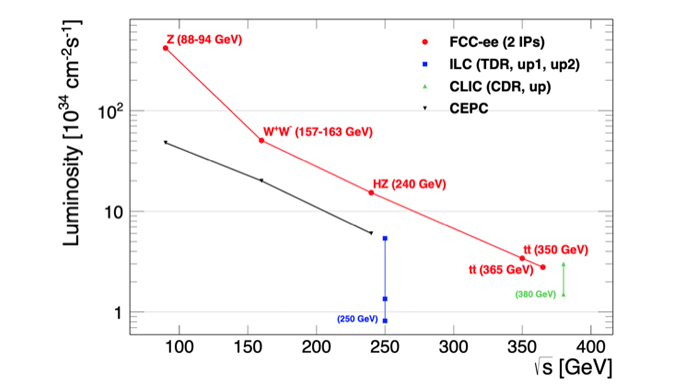
Experiments and Detectors at FCC
The HEP community is enjoying the LHC programme that is still in full swing, while future colliders provide stimulating opportunities to tackle the challenges7-9 offered by the design of the FCC, which require additional human and technical resources.
Important new LHC results are still to come, and several subdetectors are being upgraded or replaced for the High Luminosity phase and for the large amount of data that it will provide. In parallel, the physics potential of the FCC must be further explored, and the future detectors for this machine must be conceived in a way they can produce the results under the challenges presented by the ultimate precision that is aimed at.
For instance, the potential of running at lower energy (91 GeV), to produce more than 5×1012 Z, i.e., to have an electroweak factory on top of a Higgs factory, uniquely improves the discovery potential of the FCC machine. To exploit these large statistics, both detectors and theoretical predictions must be further developed to reduce systematic uncertainties. The global FCC collaboration approach is particularly well adapted to attract worldwide expertise to solve such problems.
Two working groups have been setup inside the FCC collaboration to attract resources and expertise from around the globe. One group has a more formal approach, setting up MoUs between CERN and the different countries with clear objectives, in particular to build the machine and the infrastructure. The second is more informal, with one or two national contacts in every country aiming at developing the project in their local community, in a way that is better suited for initial theoretical calculations and conceptual detector studies, and which will lead to additional MOUs.
The goals are:
- a) To build a strong consensus among all HEP physicists in every country that the FCC must be built in a timely way;
- b) To have strong support for developing/resolving the open points, in particular regarding the detector technologies, the experiments, and the physics potential; and
- c) To assemble the large physicist community which will work on FCC, in particular to design, build, and exploit the detectors in the different interaction regions. This also means uniting the existing communities established around different projects (FCC, ILC, etc.) in the not-too-distant future.
In parallel, the European Committee for Future Accelerators (ECFA) is developing a joint detector R&D roadmap, favouring developments applicable to different detectors/accelerators, and organising Higgs and electroweak factory workshops, where new developments in the technical, analysis, and theoretical fields are being shared.
Physics and data taking (‘Run’) plan at the FCC
Physics will be very diverse at the FCC, given its two ee and hh stages, the different centre-of-mass energy e+e– runs, and the large integrated luminosities which will be delivered. There will be several physics programmes, focusing on the Higgs, electroweak, heavy flavored quarks, tau-lepton physics, quantum chromodynamics, and searches for physics beyond the Standard Model, either directly (dark matter candidates or heavy neutrinos, for instance), or indirectly, via deviations from the values predicted by the SM.
The first stage FCC-ee will allow for high precision. The current data taking plan will devote four years at 88-95 GeV to produce 5×1012 Z decays (assuming two detectors around the ring, 1.7 times more with four detectors, which is an option under study), which will serve as a basis for the electroweak, heavy flavour, tau, and QCD programme. More electroweak physics will be performed with two additional years running at the WW production threshold (around 160 GeV) to measure the W mass with a few ppm precision.
The Higgs factory programme will last three years at the optimised ZH production energy (~240 GeV), to produce 106 ZH events to measure the ZH coupling to permil precision, as a reference for the whole set of Higgs properties. It is not yet clear if the FCC beam energy spread can be reduced enough to run meaningfully at the centre-of-mass value of the Higgs mass (~125GeV) to discover the Yukawa interaction of the Higgs boson with electrons, but if this is indeed possible, it would necessitate three years of running with our current estimates.
Finally, to complete the first stage programme, five years run at the top-antitop production threshold (345-365 GeV) would allow for the collection of 106 tt and 6×104 Hѵѵ events, which will provide further study of the top quark and of the Higgs boson.
A first determination of the Higgs self-coupling strength will then be possible by a combination of all Higgs data. After these ~15 years of data taking and a ~10-year shutdown to install and commission the hadron collider, in particular its 100km of high field (~16 Tesla) superconducting magnets, there will be a 25-year operation time to fully exploit the 100 TeV physics programme at the highest energy ever reached in a lab.
The complementarity between the FCC-ee and FCC-hh stages is essential to obtain the largest spectrum of Higgs and electroweak measurements at the highest precision. However, after the first stage much progress will have already been made to accomplish the FCC Higgs and electroweak programmes.
In Fig. 2, we see that FCC-ee is optimally placed compared to its competitors to cover all these aspects. Similarly, FCC-hh is more ambitious than its competitor, the Chinese project SppC, in terms of centre-of-mass energy (100 TeV vs. 75 TeV) and luminosity (20 vs. 10 ab-1), and will produce, for instance, more than 2×1010 Higgs bosons.
After FCC-ee, the physics programme will already be in an excellent position, with most of the Higgs boson couplings known to the sub-percent level precision, and electroweak measurements improved by one or two orders of magnitude to study/test many of the proposed BSM models aiming to explain the present open questions. A notable exception will be the self-coupling of the Higgs, which will be known ‘only’ at the 20-30% precision level, until FCC-hh brings this precision down to the 3-5% level, hence allowing the long-sought Higgs potential shape to be measured and the validity of the SM in this area to be tested as well.
The FCC-ee electroweak programme will have also taken major steps forward, and all the electroweak observables, such as the mass or the width of the Z boson, will have been measured with at least one order of magnitude better precision, thereby increasing the chances to observe deviations due to beyond the Standard Model effects, hence probing effective mass scales up to 70 TeV.8,9 The other fields (searches for dark matter and feebly coupled particles, heavy flavour, and QCD) will also have made significant progress, hence the chance to discover unexpected phenomena rather early in the programme is significant.
Following this first stage of the lepton collider FCC-ee, the second stage FCC-hh will reach the new energy frontier of 100 TeV, almost one order of magnitude higher than the LHC, and will be even more exciting with the additional direct discovery potential in the new kinematic regime.
In summary, given the wealth of expected fundamental results and potential discoveries, it is crucial not to delay the start of the process to realise this extraordinary machine. While continuing running the LHC at its highest performance, the particle physics community is investing significant human and technical resources to demonstrate the FCC feasibility by 2025.
References
- 1 TeV (or 1 Tera electron-Volt) is equal to 1,000 GeV, or about 1,000 proton masses
- European Strategy for Particle Physics Preparatory Group. Physics Briefing Book (CERN, 2019);
- https://fcc-cdr.web.cern.ch
- The FCC Collaboration. ‘FCC physics opportunities’. Eur. Phys. J. C 79, 474 (2019)
- The FCC Collaboration. ‘FCC-ee: The Lepton Collider’. Eur. Phys. J. Spec. Top. 228, 261–623 (2019)
- The FCC Collaboration. ‘FCC-hh: The Hadron Collider’. Eur. Phys. J. Spec. Top. 228, 755–1107 (2019)
- Benedikt, M. et al. ‘Future Circular Colliders’. Ann. Rev. Nuc. Part. Sci. 69, 389–415 (2019)
- Benedikt, M. et al. ‘Future Circular Colliders succeeding the LHC’. Nature Physics, 16, 402–407 (2020)
- A. Blondel and P. Janot, ‘FCC-ee overview: new opportunities create new challenges, submitted to EPJ+ special issue: A future Higgs and Electroweak factory (FCC): Challenges towards discovery, Focus on FCC-ee
Please note, this article will also appear in the seventh edition of our quarterly publication.

